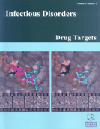- Home
- A-Z Publications
- Infectious Disorders - Drug Targets (Formerly Current Drug Targets - Infectious Disorders)
- Previous Issues
- Volume 12, Issue 4, 2012
Infectious Disorders - Drug Targets (Formerly Current Drug Targets - Infectious Disorders) - Volume 12, Issue 4, 2012
Volume 12, Issue 4, 2012
-
-
Airway Management in Pediatric Head and Neck Infections
More LessAuthors: Nicolas Leboulanger and Erea-Noel GarabedianInfectious diseases of the head and neck in children are very common but may sometimes cause upper airway obstruction. Various degrees of respiratory distress are possible, but one will be extra-cautious with newborns and neonates, because the clinical features can evolve especially fast in young children. A child with a respiratory compromise should never be left unattended. Nasal, pharyngeal, and laryngeal airways can Read More
-
-
-
Otitis Media: Epidemiology and Management
More LessAuthors: Anna Hang and Scott E. BrietzkeOtitis media is one of the most common disease entities in children worldwide. This critical review of the literature will focus on the demographics, pathophysiology, diagnosis, and medical and surgical management of the various types of otitis media.
-
-
-
Complications of Otitis Media
More LessAuthors: James J. Daniero, Matthew S. Clary and Robert C. O’ReillyOtitis media is the most common reason for antibiotic prescription in the United States. Whether due to disease virulence or growing antimicrobial resistance, complications of otitis media seem to be seen more frequently. These complications may be difficult to identify and treat. This article focuses on the pathophysiology of these complications and address medical and surgical approaches to safe treatment.
-
-
-
Acute Tonsillitis
More LessAuthors: Doug Sidell and Nina L. ShapiroAcute tonsillitis is an inflammatory process of the tonsillar tissues and is usually infectious in nature. Acute infections of the palatine tonsils predominantly occur in school-aged children, but patients of any age may be affected. Tonsillitis of viral origin is usually treated with supportive care. Bacterial tonsillitis is most commonly caused by Streptococcus pyogenes. Polymicrobial infections and viral pathogens are also imp Read More
-
-
-
Pediatric Peritonsillar Abscess: An Overview
More LessAuthors: Cristina Baldassari and Rahul K. ShahPeristonsillar abscess (PTA) is a common deep neck space infection in children. Children with PTA often present with sore throat, dysphagia, peritonsillar bulge, uvular deviation, trismus, and a muffled voice. The diagnosis of PTA can be made based on history and physical examination in the majority of children. Treatment of pediatric PTA necessitates aspiration or surgical drainage and antibiotic therapy. Challenges exist Read More
-
-
-
Chronic Streptococcal and Non-Streptococcal Pharyngitis
More LessAuthors: R. C. Murray and S. K. ChennupatiPharyngitis is a common medical problem in the outpatient medical setting, resulting in more than seven million pediatric visits each year. Most types of pharyngitis are caused by infectious etiologies. The most common cause of pharyngitis is viral infection; however, some of the more serious types of pharyngitis are attributed to bacterial etiologies, such as group A β-hemolytic Streptococcus pyogenes (GAS). Complicat Read More
-
-
-
Deep Neck Infections
More LessAuthors: David E. Conrad and Sanjay R. ParikhDeep neck space infections are commonly seen and managed across various medical and surgical specialties. Common presentations permit straightforward management but still pose the risk of severe complications sometimes even with appropriate management. This article emphasizes the anatomic and physiologic process to heed when managing children with deep neck infections. The roles of radiography and medical Read More
-
-
-
Retropharyngeal Abscess: Diagnosis and Treatment Update
More LessAuthors: Brian K. Reilly and James S. ReillyRetropharyngeal abscess is a deep neck space infection that may present in various subtle ways permitting potentially lethal complications to occur before appropriate diagnosis is made and expedient management undertaken. This article reviews in detail the pertinent anatomy, diagnostic pearls, and clinical recommendations to optimally manage these common infections in children.
-
-
-
Inflammatory Mechanisms and Redox Status in Periodontal and Cardiometabolic Diseases: Effects of Adjunctive Nutritional Antioxidants and Statins
More LessBy Mena SooryPeriodontal pathogens in plaque biofilm initiate periodontitis, which is influenced by genetic and environmental factors. The resultant pro-oxidant status imposed on the periodontium, exacerbated by episodic hyperinflammatory damage contributes to progression of periodontitis and tooth loss in susceptible subjects. Increasing documentation of bi-directional connections between periodontal and cardiometabolic disorders mak Read More
-
-
-
Lacticin LC14, a New Bacteriocin Produced by Lactococcus lactis BMG6.14: Isolation, Purification and Partial Characterization
More LessA new bacteriocin, lacticin LC14, produced by Lactococcus lactis BMG6.14, was isolated and characterized. It was purified to homogeneity from overnight broth culture by ammonium sulfate precipitation, Sep-Pak chromatography, and two steps of reversed-phase HPLC. Lacticin LC14 showed bactericidal-type antimicrobial activity against several lactic acid bacteria and pathogenic strains including Listeria monocytogenes. It w Read More
-
Volumes & issues
-
Volume 25 (2025)
-
Volume 24 (2024)
-
Volume 23 (2023)
-
Volume 22 (2022)
-
Volume 21 (2021)
-
Volume 20 (2020)
-
Volume 19 (2019)
-
Volume 18 (2018)
-
Volume 17 (2017)
-
Volume 16 (2016)
-
Volume 15 (2015)
-
Volume 14 (2014)
-
Volume 13 (2013)
-
Volume 12 (2012)
-
Volume 11 (2011)
-
Volume 10 (2010)
-
Volume 9 (2009)
-
Volume 8 (2008)
-
Volume 7 (2007)
-
Volume 6 (2006)
Most Read This Month
Article
content/journals/iddt
Journal
10
5
false
en


